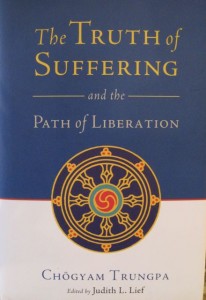Saturday
Featured Stories, Mandala ProjectsRooted in the Three Yanas
Based on an interview with Acharya Judy Lief
Click here to read Buddhist Lists Meet Dharmic Riffs, a Q & A with Acharya Lief about the Root Text Project.
Every year, starting in 1973 until he died in 1986, Chogyam Trungpa Rinpoche taught a seminary that lasted three months. With each month devoted to one of the three yanas — hinayana, mahayana, and vajrayana — these seminaries were important not only for the people who attended, but for the sangha as a whole. Each year, the Vidyadhara contributed something new, building on what he taught the previous year, discussing nuances, and going ever deeper into the meaning of the teachings.
As the years have passed, students of the Vidyadhara, Shambhala, and Buddhism in general have used the transcripts from these seminaries as root texts. Transcripts from some years have been on required reading lists and others grew in popularity, but it was never clear where the root of these abundant teachings lay. But as even more time passes, students are referring to the seminary transcripts less and less because – unless they attended that particular seminary and therefore have a certain nostalgia – the transcripts make finding comprehensive information on a given topic very challenging.
In the late 1970’s, the Vidyadhara asked that the teachings from his seminaries be gathered and reworked into a three-volume set. He described one volume for each of the three yanas, which would form a compendium of the path that could be used by scholars in libraries, by practitioners from other sanghas, and of course, by future generations.
At the time of this request, Judy Lief was the editor at Vajradhatu Publications in Boulder. She and Sarah Coleman made an early stab at compiling the volumes in the days when “cut and paste” literally meant that you cut with scissors and pasted with glue. They cut the transcripts into many pieces and played with them a bit, but then Judy took a job at Naropa University. The pieces sat in boxes at Vajradhatu Publications and while they languished for nearly a decade, they were not forgotten.
 When the Vidyadhara died, his editors realized that the project was lingering as an unfulfilled wish of their teacher. They revisited it often, but it was a hot potato that no one wanted to jump in and complete, knowing the sheer amount of work and resources required. Jim Green made an early attempt at the hinayana volume — without the help of computers — and while it was a gallant effort, it didn’t work out.
When the Vidyadhara died, his editors realized that the project was lingering as an unfulfilled wish of their teacher. They revisited it often, but it was a hot potato that no one wanted to jump in and complete, knowing the sheer amount of work and resources required. Jim Green made an early attempt at the hinayana volume — without the help of computers — and while it was a gallant effort, it didn’t work out.
Once computers arrived on the scene, transcripts were digitized and original recordings were made into MP3s. These tools made the process fathomable. The relationship between Vajradhatu Publications and Shambhala Publications became closer, and they began to envision this project as a collaborative endeavor. As everyone who cared about the project realized they were getting older, their motivation to complete it grew stronger. The conditions were coming together and, as Judy Lief says, “We realized that if anyone’s going to do it, it’s got to be us.”
But even then, complexity kept them from getting started, and hampers the process still. Because it is a five-year project, with intensive editorial labor required, and a low cost-to-profit ratio, many different parties have gathered to fund it, including Vajradhatu Publications, Shambhala Publications, the Shambhala Trust, and individual donors.
Once Acharya Judy Lief figured out how to almost entirely clear her schedule – except for teaching — she started going through material. For the last two years, she has devoted almost all of her time to it. With the help of her research assistant, Ellen Kearney, and with continued resources, Acharya Lief has been able to establish a pace that she hopes will lead to the project’s completion in 2012.
 This April, a book was published on the four noble truths called The Truth of Suffering and The Path to Liberation (Shambhala Publications, 2009). This book is what Acharya Lief calls a “topical volume,” which pulls together material on a given topic from multiple seminaries. But this book is only a teaser of what’s to come – while there will be more smaller, topical books, in the larger project there will be around 500 pages for each yana, arranged by topic. In the hinayana volume, some examples include teachings on shamatha, vipashyana, the four noble truths, egolessness, and karma.
This April, a book was published on the four noble truths called The Truth of Suffering and The Path to Liberation (Shambhala Publications, 2009). This book is what Acharya Lief calls a “topical volume,” which pulls together material on a given topic from multiple seminaries. But this book is only a teaser of what’s to come – while there will be more smaller, topical books, in the larger project there will be around 500 pages for each yana, arranged by topic. In the hinayana volume, some examples include teachings on shamatha, vipashyana, the four noble truths, egolessness, and karma.
Just as the Root Text Project is coming together, two parallel endeavors are also happening. For students who want access to the original transcripts, in which the teachings are offered verbatim, there is going to be a searchable DVD. Barbara Blouin is in the process of checking the accuracy of the transcriptions from beginning to end. In addition, there will be supplemental material of historical interest, such as the history of the seminaries and photographs.
The Vidyadhara had two intentions for the seminary teachings. He considered them to be a container in which he could offer his core teachings to the students he was close to. And at the same time, he wanted them to be offered in the public domain, released out in the world so that many people — beyond his students, our sangha, and even people living in our lifetime — would have a record of the teachings he gave. Bringing them all together and making them accessible fulfills these intentions.
All purchases made through the Shambhala Shop will benefit The Root Text Project. Click here to purchase The Truth of Suffering and the Path of Liberation.





